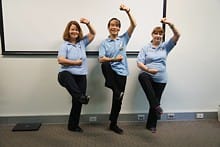Extending the Principles
By: Dr Paul Lam
© Copyrighs Tai Chi Productions 2007. All rights reserved, no 
To improve your tai chi, it is essential to progress in four different “directions”, jing, song, chen, and huo. These are extensions of the tai chi principles. The following repeats some of that information but explores it in different and deeper ways.
The four directions complement each other, so you don’t need to be completely proficient in one before moving on to another. They also affect each other positively, so that by learning more about one you will improve your understanding of the others. Try working on one direction for a period of at least a few weeks and then move on to another. But come back to each one regularly.
Some of the concepts below might not be clear to you. Don’t let that concern you. As you progress further, you’ll be able to understand them. In time, as your level of understanding deepens, the words will take on a somewhat different meaning. Bear in mind that no one reaches perfection in all four directions; progression is what matters.

Attaining a degree of mental quietness will take time. But once you have achieved it, it will stay with you. The next time you practise, your mind will be able to relocate the same state, and gradually you’ll be able to move on to an even higher level. Jing improves relaxation; it allows you to focus. This, in turn, enhances balance and relieves muscle tension, making your tai chi practice more effective.
The mental quietness of tai chi is different from that of other forms of meditation. While you are serene from within, you are still aware of your environment and able to assess the situation around you at any time – a necessity when you’re performing tai chi as a martial art. Although jing might be a more difficult mental state to achieve than, say, meditation, once attained it will help you deal with not only a martial art fight but with any crisis in real life. Even just saying the word jing quietly to yourself may help to induce the state.
Now apply this technique to other joints. Visualize them loosening. In the upper limbs, loosen your elbows, wrists and finger joints by stretching them out in the opposite direction, almost like gently pulling the joint open. In the torso, the loosening should be vertical – visualize your spine as a string that you gently stretch from both ends. For the lower limbs, stretch your hip joints and knee joints gently outwards, so that your crouch forms an arch.
This method of loosening constitutes a type of controlled relaxation, because when you gently stretch your joints, you’re attaining song, and you can’t be tense. Song helps your qi flow, builds internal strength and also improves flexibility. It will also enhance jing. Once you develop song, your mind becomes jing as well, and as your mind becomes more jing, your song will improve, thus setting up a positive circle.

Exhaling facilitates sinking qi to the dan tian, which in turn keeps your mind jing and loosens up your joints. You’ll find using the abdominal breathing method will help you to feel the sensation of qi. This sensation differs from person to person, but for most, it’s a warm, heavy feeling. As you breathe out, loosen your joints. You should feel a warm and heavy feeling in your dan tian. That’s the feeling of sinking your qi. If you don’t feel this initially, don’t worry. Continue to practise the form. As you improve, you’ll eventually feel the qi in the dan tian and learn how to sink it.
Chen enhances stability, song, and qi cultivation. Awareness of the dan tian will strengthen the internal structures of your body, and improve your inner strength, and strengthen your spine.

Huo means “agility”. Being strong, having powerful qi, and being in a good mental state are essential, and these attributes will be even more effective with better agility. Agility comes from regular practice with the proper body posture, weight transference, control of movements, loosened joints, and strong internal strength. Agility aids qi cultivation and improves flexibility.
- The Tai Chi Principles
- How to improve your tai chi
- Strategies for improvement
- Working with a teacher
- Which DVD should you buy?



